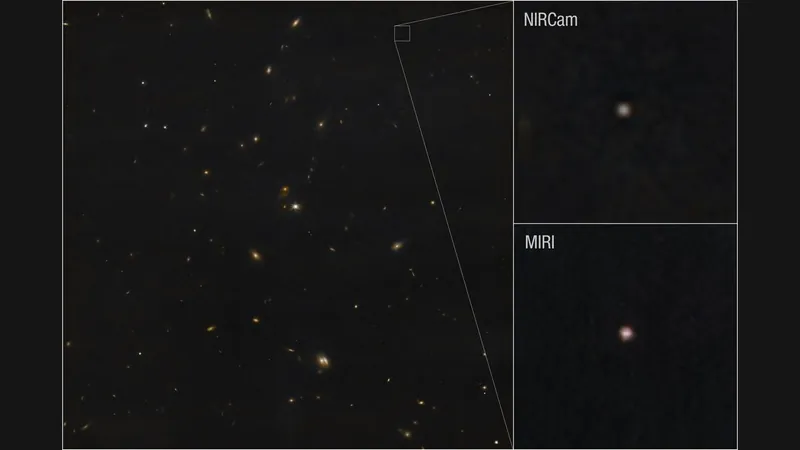
Astounding Discovery! James Webb Telescope Reveals Secrets of 'City-Killer' Asteroid 2024 YR4 Before 2032 Close Encounter!
2025-04-03
Author: Wai
Introduction
In a groundbreaking revelation, the James Webb Space Telescope (JWST) has successfully conducted its first observation of asteroid 2024 YR4, a so-called "city-killer" asteroid poised for an alarming close approach to Earth in December 2032. This rare opportunity was made possible by the allocation of emergency telescope time to a dedicated team of international astronomers back in February.
New Findings on Asteroid Size and Composition
Initial findings from JWST indicate that 2024 YR4 is significantly larger and rockier than previous assessments suggested. A recent NASA announcement confirmed that the asteroid measures between 174 and 220 feet (53-67 meters) in diameter—akin to the height of a 10-story building. This revised estimate surpasses earlier predictions, which estimated its size at 131-295 feet (40-90 meters).
Collision Risk Assessment
Fortunately, astronomers have good news: 2024 YR4 will not strike Earth during its December 2032 flyby, with NASA affirming there is currently a 0% chance of an Earth impact. However, the risk of a collision with the moon has increased slightly, now standing at approximately 3.8%, up from an earlier estimate of around 2%. The researchers wrote in their preliminary report, "While an Earth impact by 2024 YR4 on December 22, 2032, has been ruled out, it continues to have a non-zero probability of impacting the Moon at this time."
Historical Context and Potential Impact
This asteroid was first spotted in December 2024, and due to its orbital trajectory, it frequently crosses paths with Earth. If 2024 YR4 were to collide with our planet, it could unleash destruction equivalent to 500 Hiroshima bombs, leading to catastrophic consequences for any city unfortunate enough to bear the brunt of its impact.
Observational Techniques
To clarify these risks, astronomers analyzed the asteroid using JWST's advanced infrared sensors, which detect heat emitted by the space rock. This technique provides more accurate data regarding size and composition compared to traditional ground-based telescopes that mainly capture reflected sunlight. According to ESA officials in a February 10 blog post, estimating an asteroid's size based on brightness alone can lead to significant inaccuracies, as an object's reflectivity greatly influences its apparent brightness.
Initial Observations and Findings
JWST first observed 2024 YR4 on March 26, tracking its rotation over a span of five hours. Analyzing the gathered data, researchers concluded that the asteroid is potentially up to 200 feet (60 meters) in diameter—a value that lies near the center of NASA's size estimate. They also found that 2024 YR4 is cooler than typical for an object of its kind, suggesting it may have a rockier surface than previously believed.
Moon Impact as a Scientific Opportunity
While the idea of the asteroid striking the moon seems alarming, the lunar surface regularly withstands thousands of small meteor impacts each year and bears evidence of larger collisions across its surface. An impact from 2024 YR4 could provide scientists with an extraordinary opportunity to witness the formation of a new lunar crater in real time, a rarity in space research.
Expert Opinions
Alan Fitzsimmons, a physics and math professor at Queen's University Belfast, expressed excitement: "We've got our fingers crossed for a moon impact. It would have no effect on Earth but would allow us to study the formation of a lunar crater by a known asteroid for the very first time."
Looking Ahead
Looking ahead, a second round of JWST observations is scheduled for May 2025, which will further refine our understanding of 2024 YR4's orbital trajectory, as well as the likelihood of a moon impact.
Conclusion
Stay tuned as we continue to monitor this fascinating asteroid and its cosmic journey! Will 2024 YR4 unveil its secrets, or will it evade our grasp once more? Only time will tell!



 Brasil (PT)
Brasil (PT)
 Canada (EN)
Canada (EN)
 Chile (ES)
Chile (ES)
 Česko (CS)
Česko (CS)
 대한민국 (KO)
대한민국 (KO)
 España (ES)
España (ES)
 France (FR)
France (FR)
 Hong Kong (EN)
Hong Kong (EN)
 Italia (IT)
Italia (IT)
 日本 (JA)
日本 (JA)
 Magyarország (HU)
Magyarország (HU)
 Norge (NO)
Norge (NO)
 Polska (PL)
Polska (PL)
 Schweiz (DE)
Schweiz (DE)
 Singapore (EN)
Singapore (EN)
 Sverige (SV)
Sverige (SV)
 Suomi (FI)
Suomi (FI)
 Türkiye (TR)
Türkiye (TR)
 الإمارات العربية المتحدة (AR)
الإمارات العربية المتحدة (AR)